Study on Friction Characteristics of AA7075 Aluminum Alloy under Pulse Current-Assisted Hot Stamping
Abstract
1. Introduction
2. Materials and Methods
2.1. Experimental Materials
2.2. Test Principle
2.3. Test Arrangement and Test Procedure
2.4. Material Characterization Methods
3. Results
3.1. Friction Coefficient at Different Current Densities
- (1)
- Current conduction in the material is limited to the conductive filaments. Due to the current’s contraction effect, it accumulates at the conductive filament, resulting in a rapid increase in temperature, which causes softening of the microprotrusions. This, in turn, reduces the biting depth and shear degree between the two contact surfaces, leading to less damage and significantly reduced roughness components at the contact interface.
- (2)
- The passage of current through the subsurface of the plate has a specific softening effect, which reduces plastic deformation. This softening effect is believed to enhance the migration of subsurface electrons, resulting in a decrease in the friction coefficient.
- (3)
- The increase in temperature caused by the current flow can lead to the rapid formation of an oxide film on the surface of the friction pair, which can act as a lubricant. As the current increases, the oxidation process accelerates, resulting in the formation of more lubricating oxide films on the contact surface of the aluminum alloy, which provides protection against wear. As a result, the friction coefficient tends to decrease with the increasing current, as the oxide film formed by oxidation serves as an effective lubricant [35,36].
3.2. The Effect of Current Density on Surface Friction Mechanism
3.3. Establishment of Friction Coefficient Model Based on the Current Density
4. Simulation and Experimental Validation
4.1. Finite Element Analysis of Thermoelectric Coupling
4.2. Finite Element Analysis of Thermal Stamping Forming
4.3. Results Analysis and Example Verification
5. Conclusions
- (1)
- With a speed of 4 mm/s and under the conditions of dry friction, the friction coefficient between the AA7075 aluminum alloy sheet and the P20 die steel gradually decreased with the increase in the current density, and the decreasing trend gradually slowed down. According to the surface morphology, there were many scratches and a small amount of peeling on the AA7075–T6 aluminum alloy surface, and the primary friction mechanism was furrow wear and viscous wear.
- (2)
- In pulse current-assisted stamping forming, tears occurred on the friction surface, and oxides appeared when the current increased, mainly caused by the electric heating effect.
- (3)
- When the current density was 2–10 A·mm−2, based on the variable friction model established at the current density, the fitting degree was good, which can accurately describe the friction behavior of the AA7075 aluminum alloy and the P20 die steel.
- (4)
- In pulse current-assisted stamping forming, the maximum thinning of the aluminum alloy plates occurred at the rounded corners of the convex shape, and the maximum thinning rate of the variable friction coefficient was greater than that of the constant friction coefficient. The maximum equivalent plastic strain was also concentrated at the corner of the punch, corresponding to the thinning rate result. The thickness distribution of the variable friction coefficient model was more consistent with the actual stamping parts, which verifies the effectiveness of the current friction model.
Author Contributions
Funding
Institutional Review Board Statement
Informed Consent Statement
Data Availability Statement
Conflicts of Interest
References
- Li, G.; Liu, X. Overview of the research status of automotive lightweight technology. Mater. Sci. Technol. 2020, 28, 47–61. [Google Scholar] [CrossRef]
- Wang, S.; Wang, D.; Huang, Y.; Meng, Q.; Zhang, L.; Dong, X. Research status of aluminum alloy material application in the field of automotive lightweight. Alum. Process. 2022, 3–6. [Google Scholar]
- Ren, L.; Xu, Y. Application and development of metal Materials in automobile Lightweight. Times Automob. 2021, 352, 38–39. [Google Scholar]
- Liu, Y.; Geng, H.; Zhu, B.; Wang, Y.; Zhang, Y. Research progress of high efficiency hot stamping process of high strength aluminum alloy. Forg. Technol. 2020, 45, 1–12. [Google Scholar] [CrossRef]
- Guo, Y.; Xie, Y.; Wang, D.; Zhao, J.; Du, L. Constitutive Model and Process Analysis of 2124 Aluminum Alloy Hot Forming. Forg. Technol. 2022, 47, 213–219. [Google Scholar] [CrossRef]
- Xia, J.; Zhao, J.; Dou, S. Friction Characteristics Analysis of Symmetric Aluminum Alloy Parts in Warm Forming Process. Symmetry 2022, 14, 166. [Google Scholar] [CrossRef]
- Nie, D.; Lu, Z.; Zhang, K. Hot V-bending behavior of pre-deformed pure titanium sheet assisted by electrical heating. Int. J. Adv. Manuf. Technol. 2018, 94, 163–174. [Google Scholar] [CrossRef]
- Dong, H.-R.; Li, X.-Q.; Li, Y.; Wang, Y.-H.; Wang, H.-B.; Peng, X.-Y.; Li, D.-S. A review of electrically assisted heat treatment and forming of aluminum alloy sheet. Int. J. Adv. Manuf. Technol. 2022, 120, 7079–7099. [Google Scholar] [CrossRef]
- Tiwari, J.; Balaji, V.; Krishnaswamy, H.; Amirthalingam, M. Dislocation density based modelling of electrically assisted deformation process by finite element approach. Int. J. Mech. Sci. 2022, 227, 107433. [Google Scholar] [CrossRef]
- Xiao, A.; Huang, C.; Yan, Z.; Cui, X.; Wang, S. Improved forming capability of 7075 aluminum alloy using electrically assisted electromagnetic forming. Mater. Charact. 2022, 183, 111615. [Google Scholar] [CrossRef]
- Lv, Z.; Zhou, Y.; Zhan, L.; Zang, Z.; Zhou, B.; Qin, S. Electrically assisted deep drawing on high-strength steel sheet. Int. J. Adv. Manuf. Technol. 2021, 112, 763–773. [Google Scholar] [CrossRef]
- Nie, X.; Xiao, B.; Shen, D.; Guo, W. Thermodynamically coupled stamping studies considering the deformation heat and frictional thermal effects. China Mech. Eng. 2020, 31, 2005–2015. [Google Scholar] [CrossRef]
- Tan, G. Study on Cold Stamping Forming of High Strength Steel Based on Heat-Force Coupling and Variable Friction Coefficient; Hunan University: Changsha, China, 2017. [Google Scholar]
- Wang, P. Experimental Study and Finite Element Analysis of 5052 Aluminum Alloy Sheet Stamping Forming Friction Characteristics; Hunan University of Technology: Zhuzhou, China, 2018. [Google Scholar]
- Dou, S.; Xia, J. Analysis of Sheet Metal Forming (Stamping Process): A Study of the Variable Friction Coefficient on 5052 Aluminum Alloy. Metals 2019, 9, 853. [Google Scholar] [CrossRef]
- Li, X.; Yan, X.; Zhang, Z.; Ren, M.; Jia, H. Determination of Hot Stamping Friction Coefficient of 7075 Aluminum. Metals 2021, 11, 1111. [Google Scholar] [CrossRef]
- Liu, Y. Study on High Efficiency Hot Stamping Process and High Temperature Rheological and Friction Behavior of High Strength Aluminum Alloy Sheet; Huazhong University of Science and Technology: Wuhan, China, 2018. [Google Scholar]
- Xu, Y. Study on Hot Stamping Forming Friction and Lubrication Behavior of 7075 Aluminum Alloy Sheet Material; Huazhong University of Science and Technology: Wuhan, China, 2019. [Google Scholar]
- Li, J. Study on the Adhesive Friction and Wear Behavior of 7075 Aluminum Alloy during Hot Stamping; Huazhong University of Science and Technology: Wuhan, China, 2021. [Google Scholar]
- Wang, C.; Hazrati, J.; De Rooij, M.B.; Veldhuis, M.; Aha, B.; Georgiou, E.; Drees, D.; Van den Boogaard, A.H. Temperature dependent micromechanics-based friction model for cold stamping processes. J. Phys. Conf. Ser. 2018, 1063, 012136. [Google Scholar] [CrossRef]
- Venema, J.; Hazrati, J.; Atzema, E.; Matthews, D.; van den BOOGAARD, T. Multi-scale friction model for hot sheet metal forming. Friction 2022, 10, 316–334. [Google Scholar] [CrossRef]
- Deng, L. Finite element simulation of p-friction process of plate and die at mesoscopic scale. J. Plast. Eng. 2022, 29, 196–201. [Google Scholar] [CrossRef]
- Han, J.; Ding, J.; Wu, H.; Yan, S. Mechanism analysis and improved model for stick-slip friction behavior considering stress distribution variation of interface. Chin. Phys. B 2022, 31, 034601. [Google Scholar] [CrossRef]
- Lu, J.; Song, Y.; Hua, L.; Zhou, P.; Xie, G. Effect of temperature on friction and galling behavior of 7075 aluminum alloy sheet based on ball-on-plate sliding test. Tribol. Int. 2019, 140, 105872. [Google Scholar] [CrossRef]
- Lu, J.; Song, Y.; Zhou, P.; Lin, J.; Dean, T.A.; Liu, P. Process parameters effect on high-temperature friction and galling characteristics of AA7075 sheets. Mater. Manuf. Process. 2021, 36, 967–978. [Google Scholar] [CrossRef]
- Chen, Z.; Sun, G.; Shi, G.; Li, C. Study on characterization and model of friction of sliding electrical contact of pantograph-catenary system. In Proceedings of the IECON 2017—43rd Annual Conference of the IEEE Industrial Electronics Society, Beijing, China, 29 October–1 November 2017; IEEE: Piscataway, NJ, USA; pp. 2312–2317. [Google Scholar] [CrossRef]
- Chen, C.H.; Jia, L.; Shi, G.; Hui, L.; Tang, J. A dynamic friction model for bow network carrying flow under fluctuating load. J. Liaoning Univ. Eng. Technol. (Nat. Sci. Ed.) 2021, 40, 48–55. [Google Scholar] [CrossRef]
- Ping, Y. Study on Current-Carrying Friction Characteristics and Friction Force Modeling in Bow Net under Fluctuating Contact Force; Liaoning Engineering and Technical University: Fuxin, China, 2019. [Google Scholar]
- Bao, J.; Bai, J.; Lv, S.; Shan, D.; Guo, B.; Xu, J. Interactive effects of specimen size and current density on tribological behavior of electrically-assisted micro-forming in TC4 titanium alloy. Tribol. Int. 2020, 151, 106457. [Google Scholar] [CrossRef]
- Ge, L.; Wang, S.; Yang, Z. Wear behavior of 7075 aluminum alloy and its mechanism. Spec. Cast. Non-Ferr. Alloy. 2011, 31, 178–182+205. [Google Scholar] [CrossRef]
- Guo, F.; Chen, M.; Chen, Z.; Shi, G.; Hui, L. Study on friction characteristics and modeling of sliding electric contact. J. Electrotech. Technol. 2018, 33, 2982–2990. [Google Scholar] [CrossRef]
- Li, X.; Xu, Z.; Guo, P.; Peng, L.; Lai, X. Electroplasticity mechanism study based on dislocation behavior of Al6061 in tensile process. J. Alloy Compd. 2022, 910, 164890. [Google Scholar] [CrossRef]
- Liu, Y.; Wan, M.; Meng, B. Multiscale modeling of coupling mechanisms in electrically assisted deformation of ultrathin sheets: An example on a nickel-based superalloy. Int. J. Mach. Tools Manuf. 2021, 162, 103689. [Google Scholar] [CrossRef]
- Ugurchiev, U.K.; Novikova, N.N. Features of the Analytical Method to Determine the Temperature during Electroplastic Rolling. J. Mach. Manuf. Reliab. 2023, 51 (Suppl. S1), S79–S83. [Google Scholar] [CrossRef]
- Chen, Z.H.; Dang, W.; Shi, G.; Wang, X.L.; Liu, F.S. Modelling of friction in sliding electrical contacts under fluctuating loads. J. Electr. Eng. Technol. 2019, 34, 5126–5134. [Google Scholar] [CrossRef]
- Chen, Z.H.; Tang, J.; Shi, G.; Hui, L.C.; Jia, L.M. Analysis and modeling of frictional vibration of strong current sliding electrical contacts in bow networks. J. Electr. Eng. Technol. 2020, 35, 3869–3877. [Google Scholar] [CrossRef]
- Brown, L.; Xu, D.; Ravi-Chandar, K.; Satapathy, S. Coefficient of Friction Measurement in the Presence of High Current Density. IEEE Trans. Magn. 2007, 43, 334–337. [Google Scholar] [CrossRef]
- Lu, J. 7075 Basic Research of Key Technology of Hot Stamping of High Strength Aluminum Alloy; Wuhan University of Technology: Wuhan, China, 2021. [Google Scholar]
- Gu, R.; Liu, Q.; Chen, S.; Wang, W.; Wei, X. Study on High-Temperature Mechanical Properties and Forming Limit Diagram of 7075 Aluminum Alloy Sheet in Hot Stamping. J. Mater. Eng. Perform. 2019, 28, 7259–7272. [Google Scholar] [CrossRef]



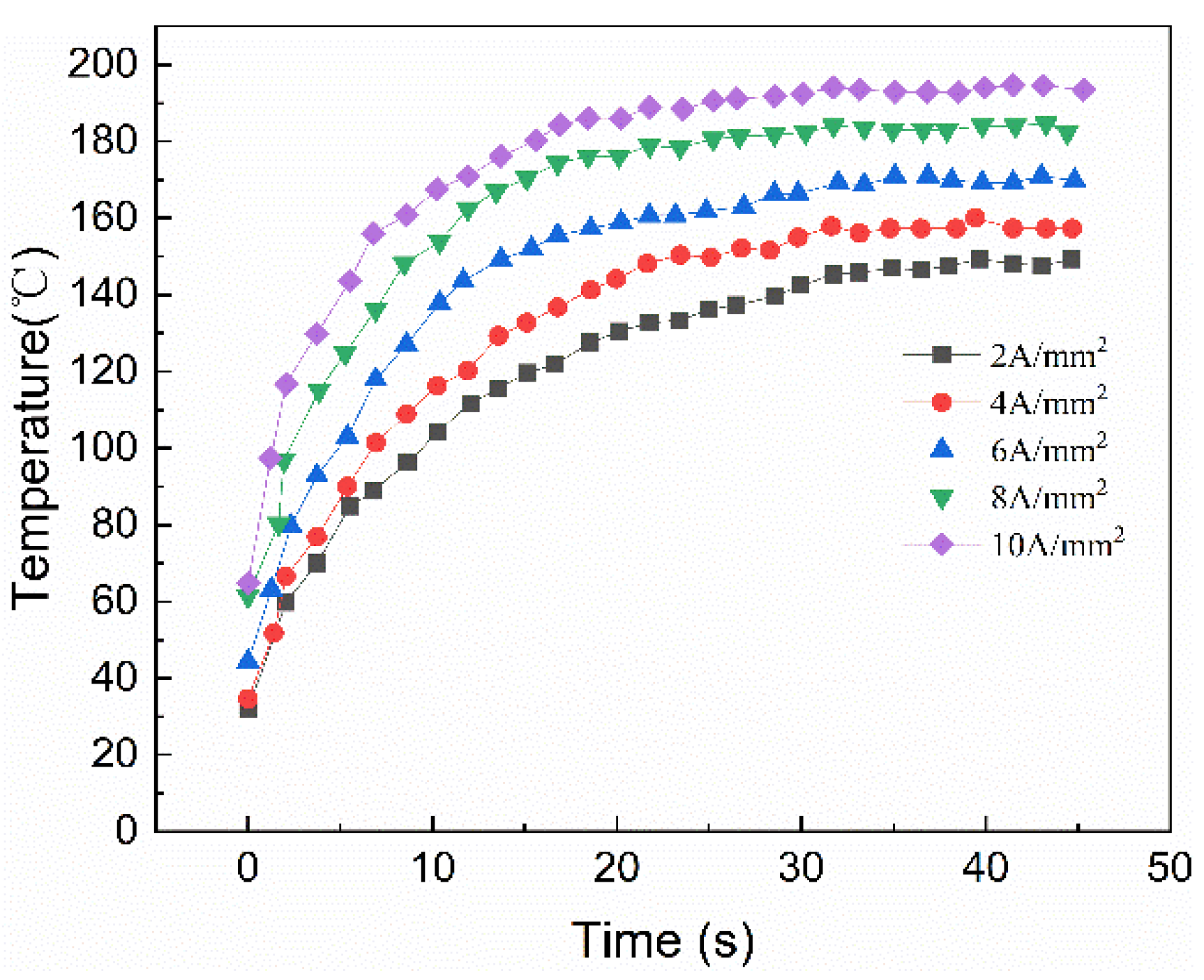

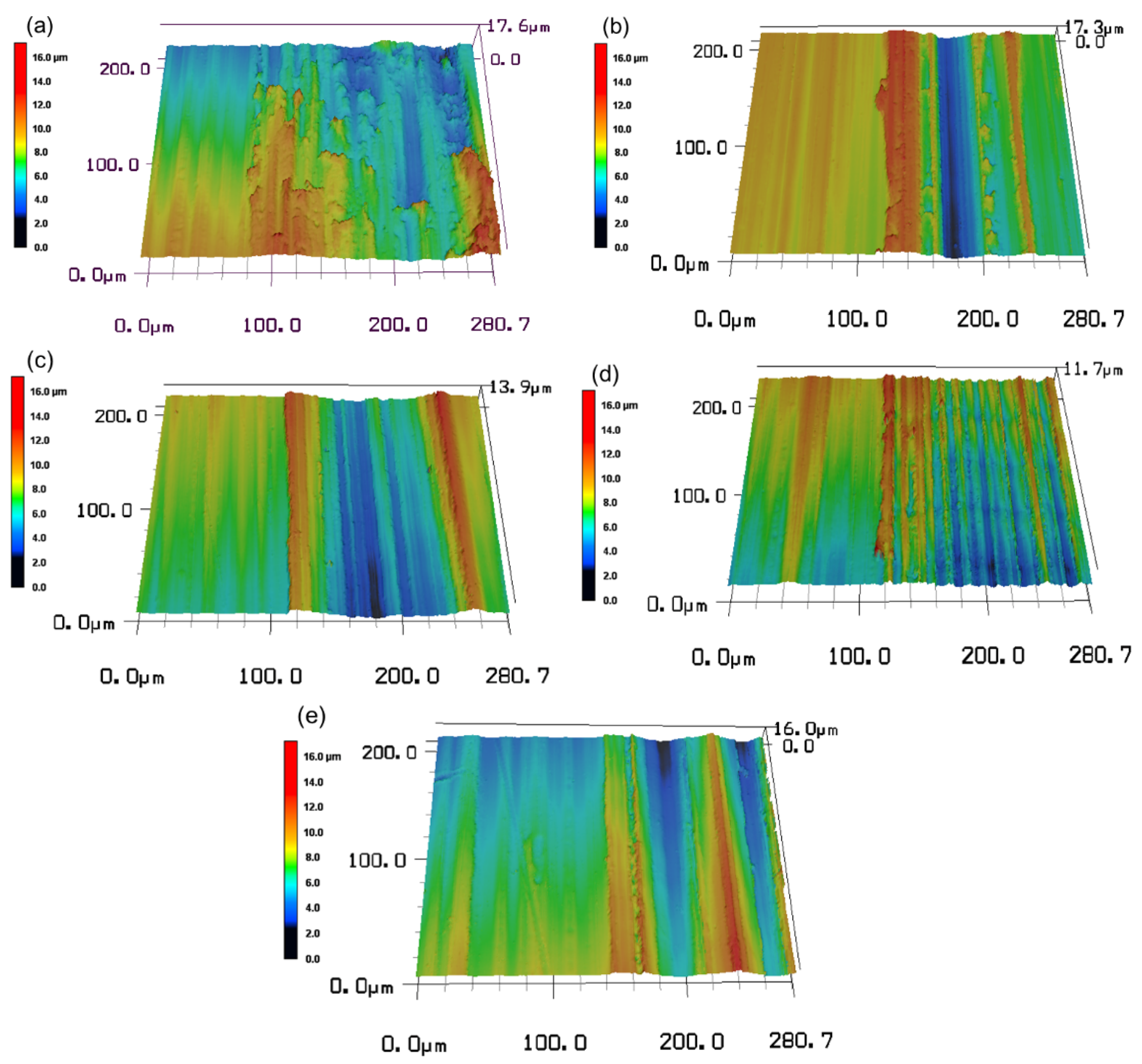
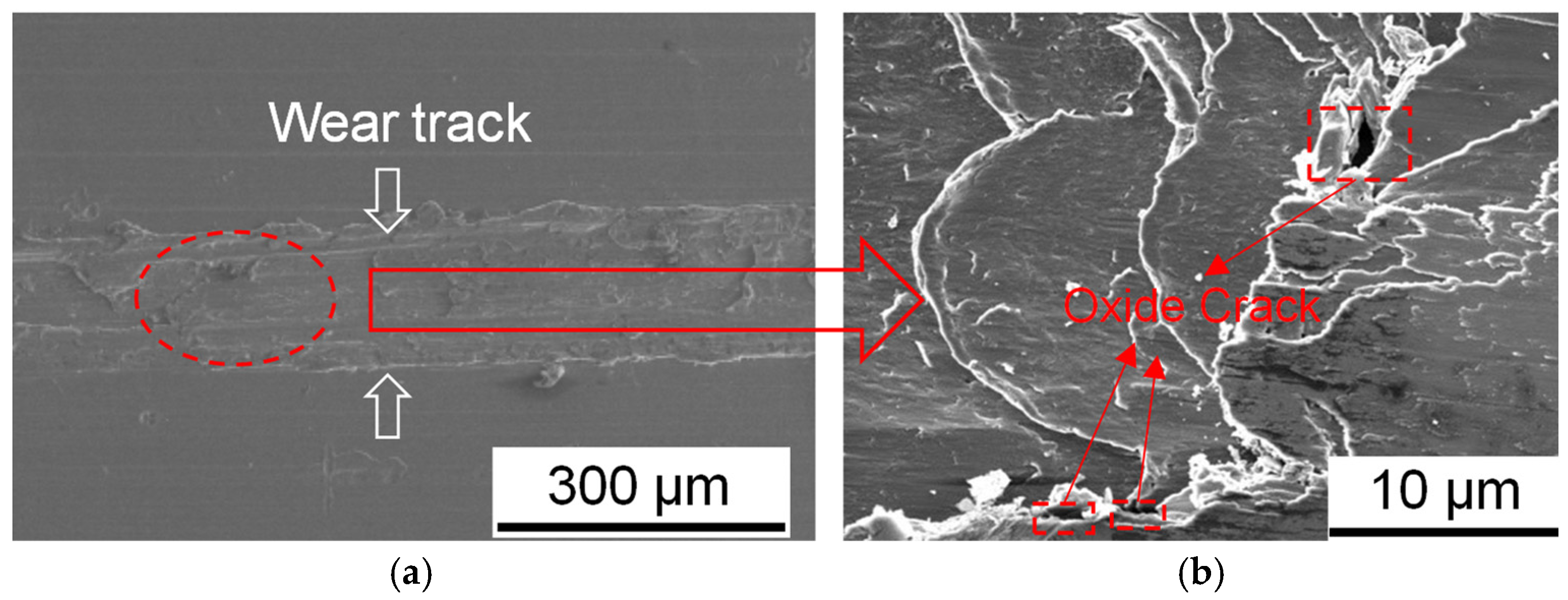
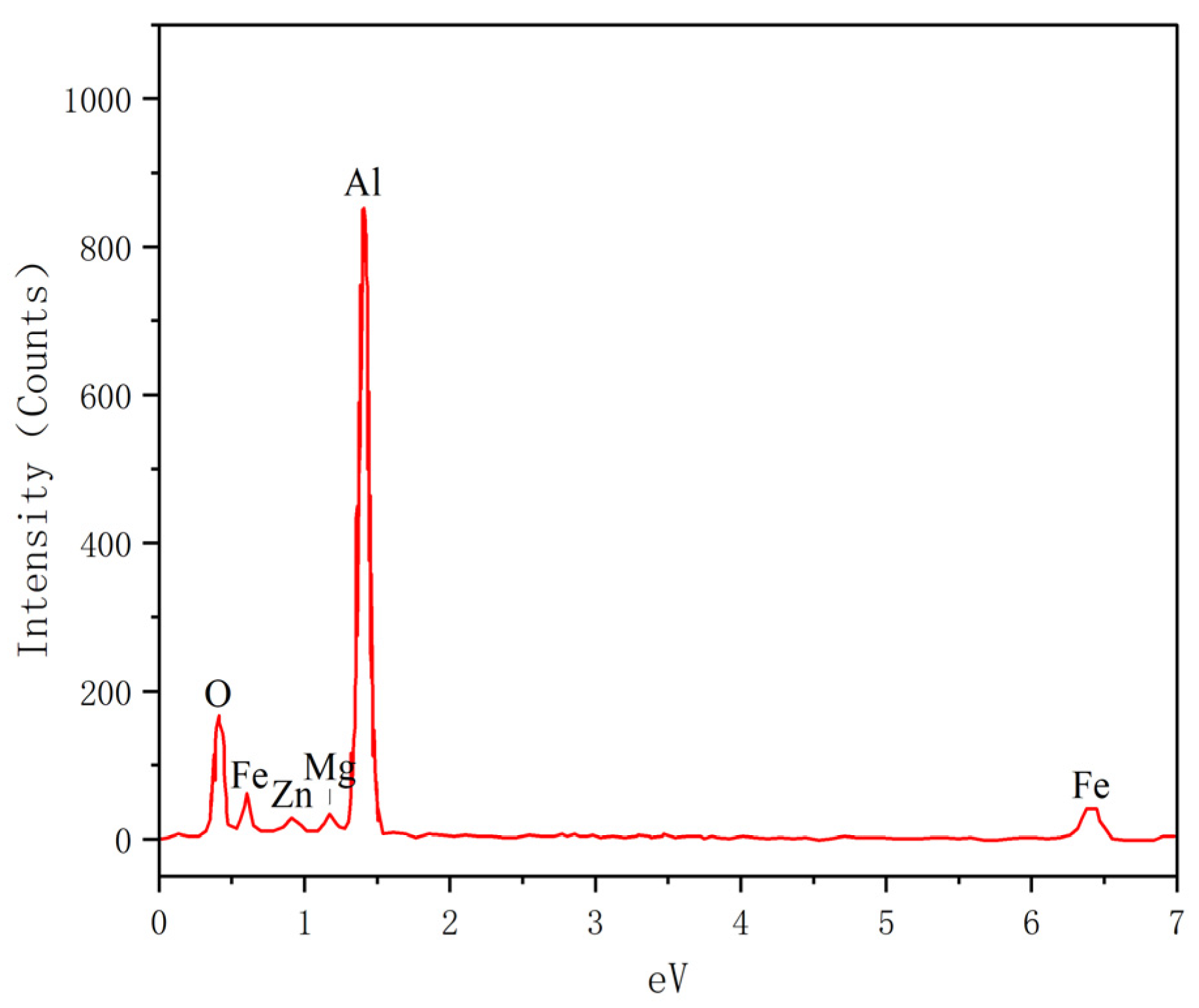
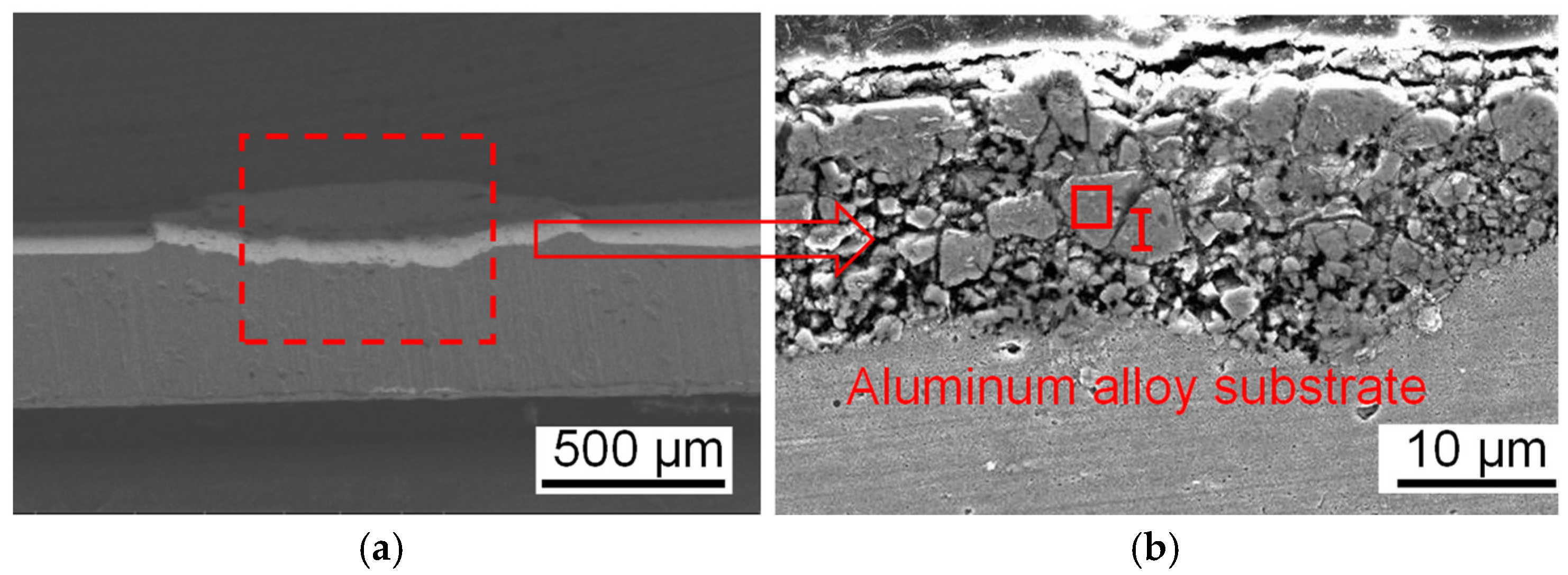
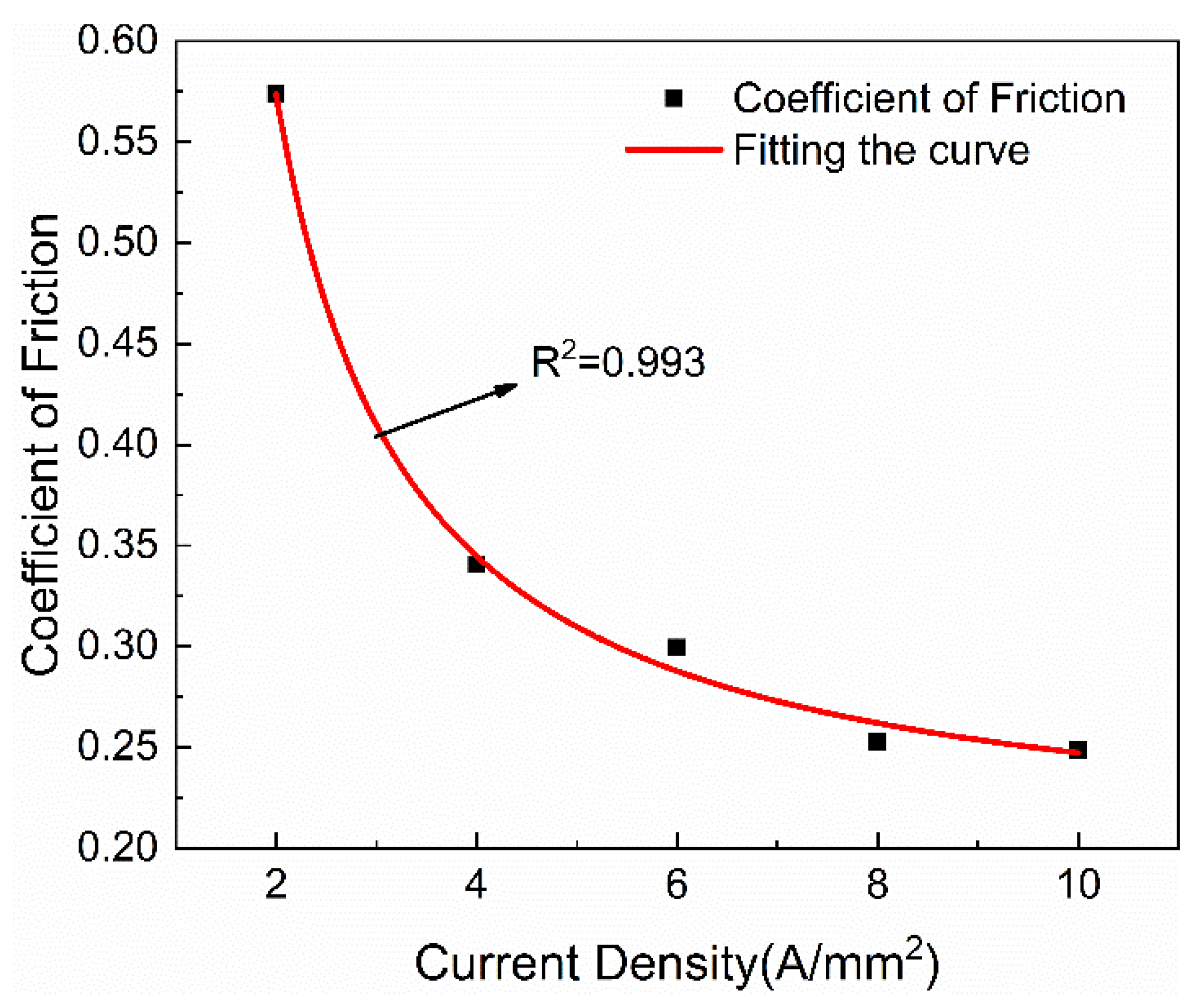
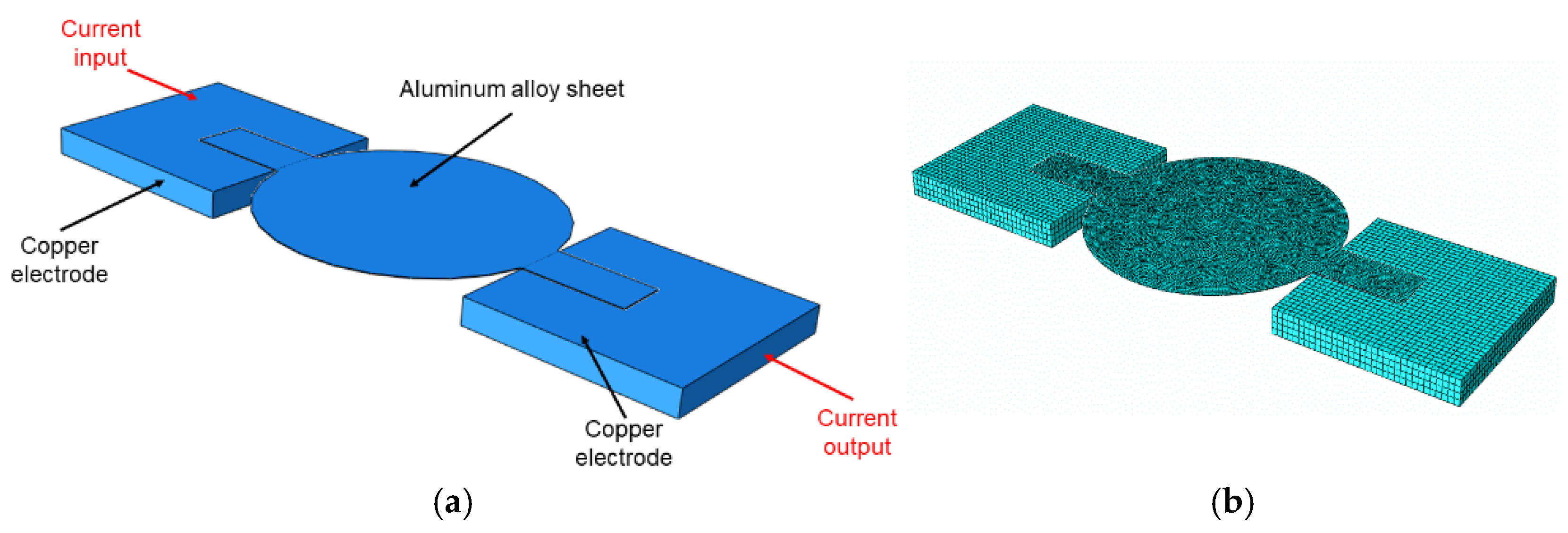
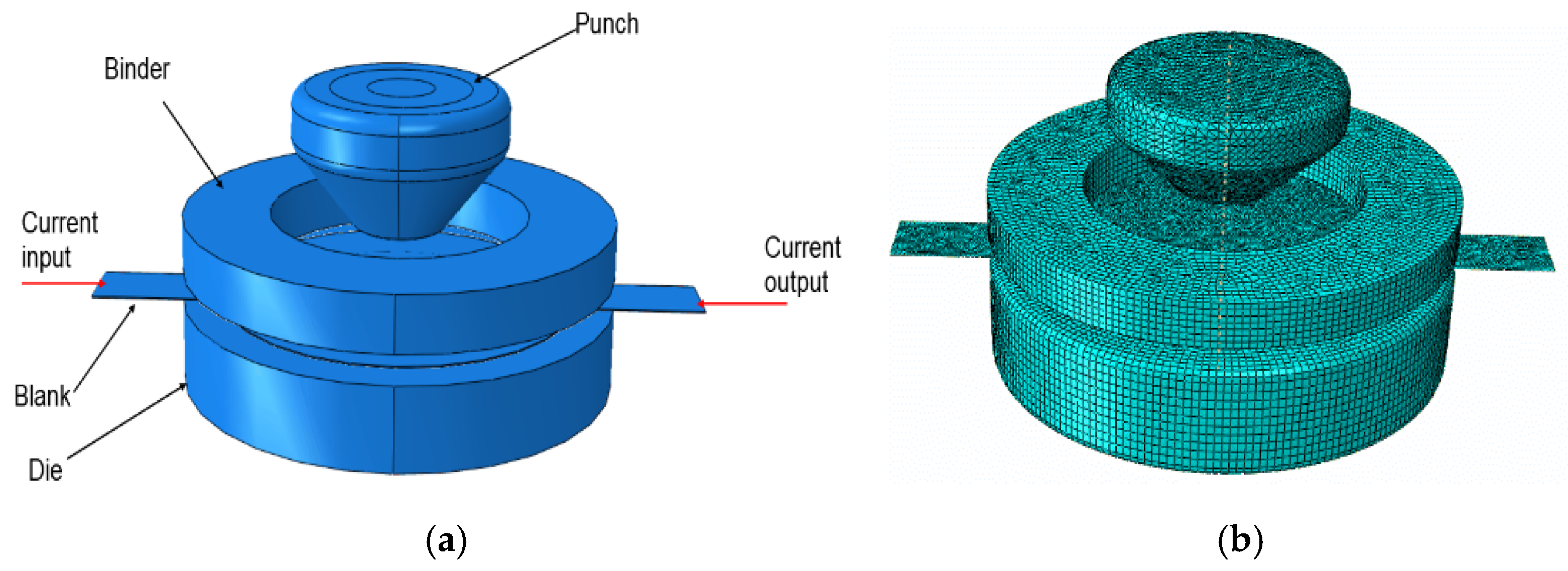

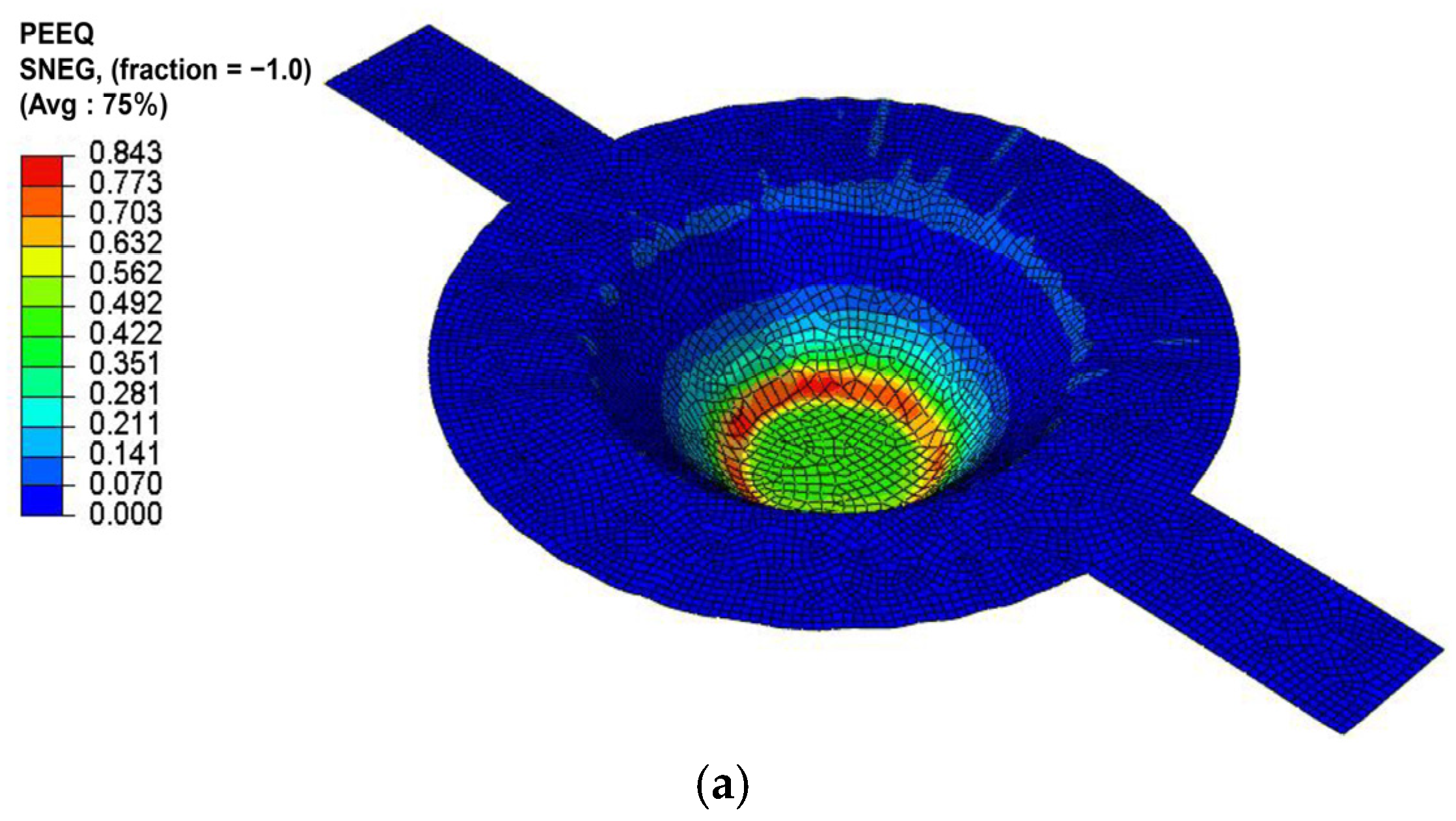
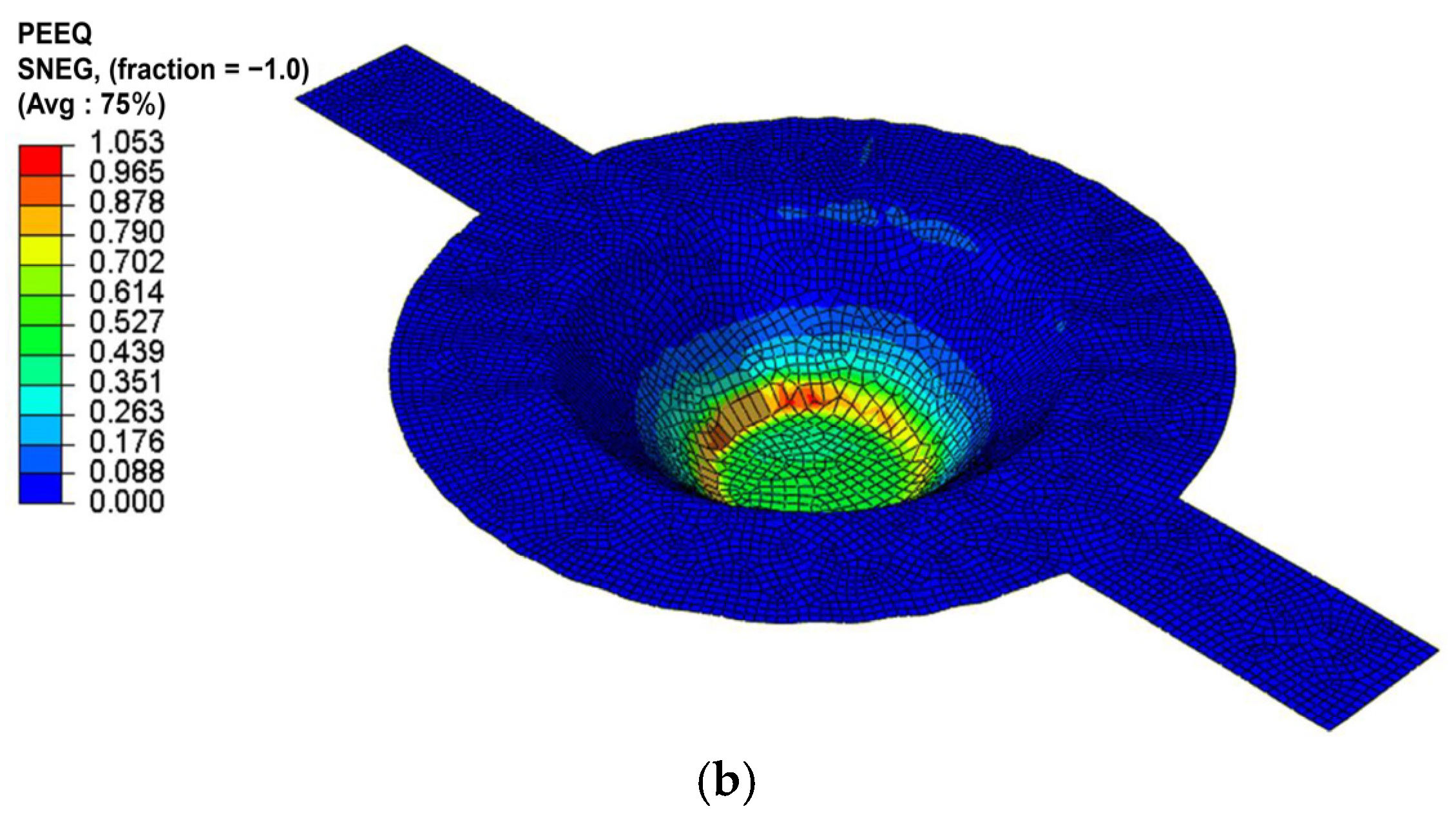
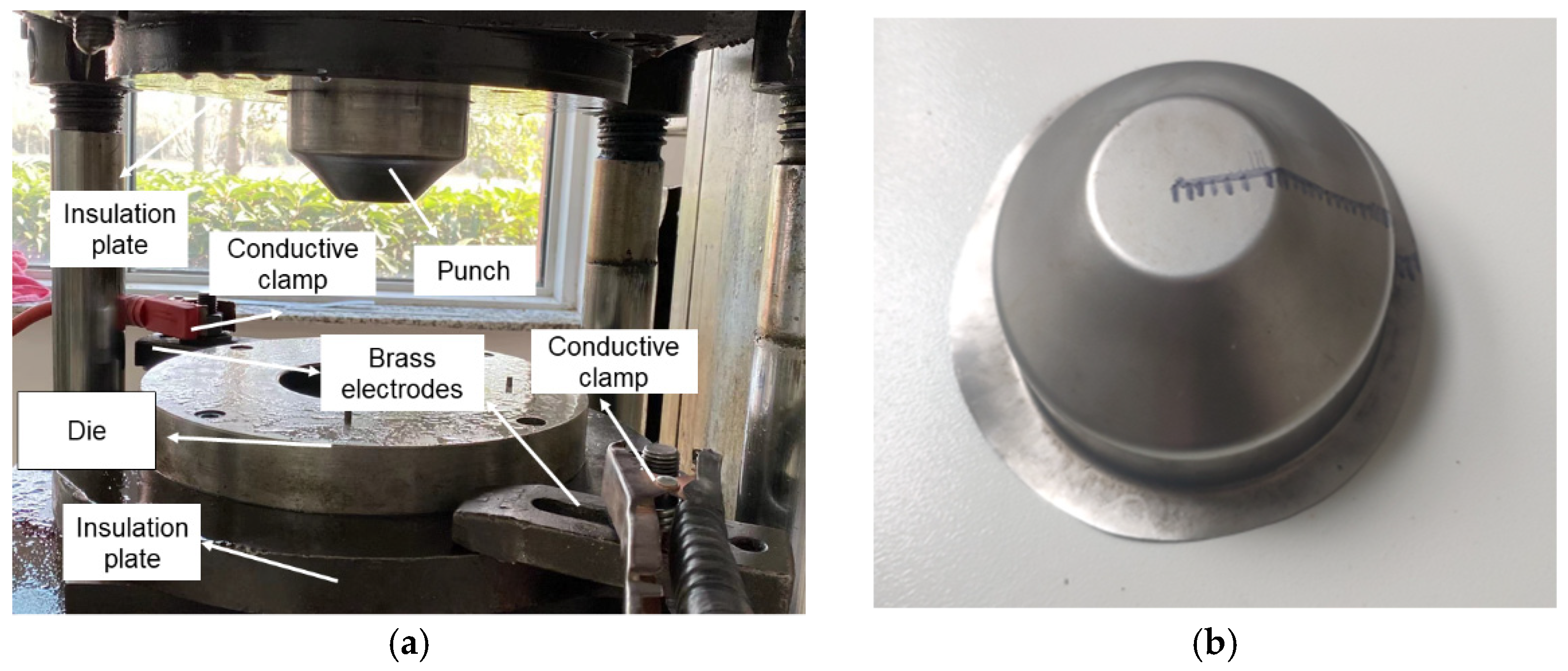
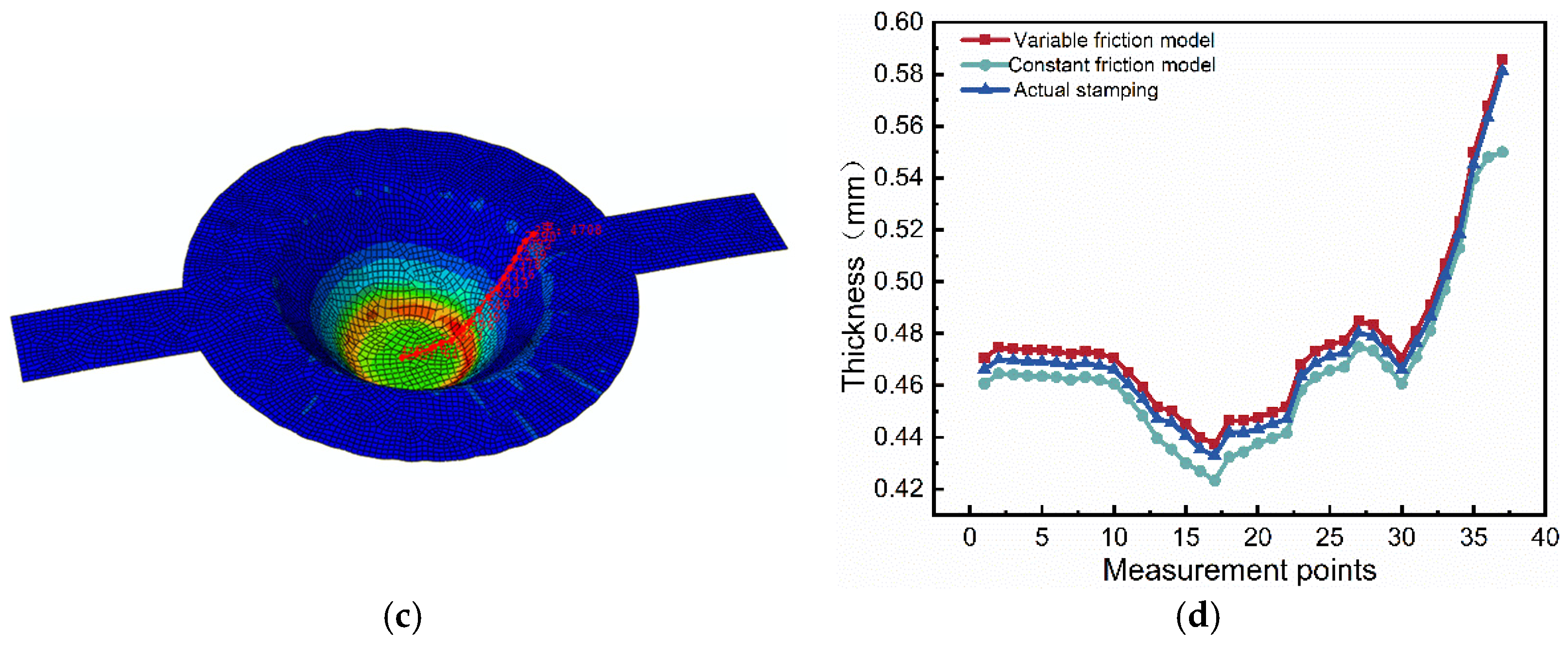
| Si | Ti | Cu | Mn | Mg | Cr | Zn | Fe | Al |
|---|---|---|---|---|---|---|---|---|
| 0.06 | 0.04 | 1.56 | 0.02 | 2.36 | 0.19 | 5.69 | 0.15 | Bal. |
| C | Mn | Cr | Mo | S |
|---|---|---|---|---|
| 0.38 | 1.3 | 1.85 | 0.40 | 0.008 |
| Load FN (N) | Sliding Speed v (mm/s) | Current Density J (A/mm2) | Stoke L (mm) | Lubricant |
|---|---|---|---|---|
| 8 | 4 | 2, 4, 6, 8, 10 | 240 | Dry friction |
| O | Al | Fe |
|---|---|---|
| 18.1% | 67.8% | 10.9% |
| Current Density (A/mm2) | 1 | 3 | 5 | 7 | 9 |
|---|---|---|---|---|---|
| Friction coefficient measurement values | 0.878 | 0.412 | 0.315 | 0.319 | 0.277 |
| Current friction model prediction values | 0.840 | 0.439 | 0.339 | 0.293 | 0.266 |
| Error (%) | 4.25 | 6.57 | 7.39 | 8.13 | 3.89 |
| Temperature (K) | Density (kg/m3) | Specific Heat Capacity (J/kg·K) | Thermal Conductivity (W/m·K) | Electroconductibility (Ω−1/mm−1) |
|---|---|---|---|---|
| 298 | 8930 | 0.385 | 400 | 59,170 |
| 373 | 8890 | 0.397 | 395 | |
| 473 | 8850 | 0.408 | 388 | 34,130 |
| 573 | 8800 | 0.419 | 382 | |
| 673 | 8740 | 0.427 | 376 | 24,814 |
| 713 | 8690 | 0.434 | 370 |
| Temperature (K) | Density (kg/m3) | Specific Heat Capacity (J/kg·K) | Thermal Conductivity (W/m·K) | Thermal Expansion (μm/m·k) | Electroconductibility (Ω−1/mm−1) |
|---|---|---|---|---|---|
| 298 | 2810 | 0.85 | 121.1 | 21.6 | 19,417 |
| 373 | 0.90 | 129.4 | 23.4 | ||
| 473 | 0.95 | 138.6 | 23.6 | ||
| 573 | 0.97 | 146.6 | 24.3 | ||
| 673 | 1.00 | 154.1 | 25.2 | ||
| 713 | 1.08 | 160.5 | 25.6 |
| Temperature (K) | 373 | 473 | 573 | 673 | 773 |
|---|---|---|---|---|---|
| Convection heat exchange coefficient (W/m2·K) | 17 | 18 | 19 | 22 | 23 |
| Punch Profile Radius (mm) | Bottom Round Angle Radius (mm) | Die Profile Radius (mm) | Pressure Rim Diameter (mm) | Die Profile Radius (mm) | Die Profile Radius (mm) |
|---|---|---|---|---|---|
| 20 | 4 | 60 | 120 | 106 | 5 |
| Density (g/cm3) | Yield Stress (MPa) | Heat Conductivity (W/m·K) | Thermal Expansion (10−6 °C) | Specific Heat Capacity (J/kg·K) | Electroconductivity (Ω−1/mm−1) |
|---|---|---|---|---|---|
| 7.81 | 836 | 31.5 | 12.8 | 460 | 1370 |
Disclaimer/Publisher’s Note: The statements, opinions and data contained in all publications are solely those of the individual author(s) and contributor(s) and not of MDPI and/or the editor(s). MDPI and/or the editor(s) disclaim responsibility for any injury to people or property resulting from any ideas, methods, instructions or products referred to in the content. |
© 2023 by the authors. Licensee MDPI, Basel, Switzerland. This article is an open access article distributed under the terms and conditions of the Creative Commons Attribution (CC BY) license (https://creativecommons.org/licenses/by/4.0/).
Share and Cite
Xia, J.; Liu, R.; Zhao, J.; Guan, Y.; Dou, S. Study on Friction Characteristics of AA7075 Aluminum Alloy under Pulse Current-Assisted Hot Stamping. Metals 2023, 13, 972. https://doi.org/10.3390/met13050972
Xia J, Liu R, Zhao J, Guan Y, Dou S. Study on Friction Characteristics of AA7075 Aluminum Alloy under Pulse Current-Assisted Hot Stamping. Metals. 2023; 13(5):972. https://doi.org/10.3390/met13050972
Chicago/Turabian StyleXia, Jiansheng, Rongtao Liu, Jun Zhao, Yingping Guan, and Shasha Dou. 2023. "Study on Friction Characteristics of AA7075 Aluminum Alloy under Pulse Current-Assisted Hot Stamping" Metals 13, no. 5: 972. https://doi.org/10.3390/met13050972
APA StyleXia, J., Liu, R., Zhao, J., Guan, Y., & Dou, S. (2023). Study on Friction Characteristics of AA7075 Aluminum Alloy under Pulse Current-Assisted Hot Stamping. Metals, 13(5), 972. https://doi.org/10.3390/met13050972






